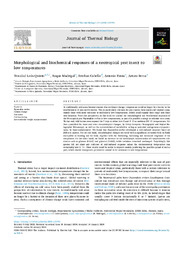Título :
Morphological and biochemical responses of a neotropical pest insect to low temperatures |
Autor :
Madrigal, ROQUE FERNANDO
León-Quinto, Trinidad 
Cabello García, Esteban 
Fimia, Antonio 
Serna, Arturo  |
Editor :
Elsevier |
Departamento:
Departamentos de la UMH::Ciencia de Materiales, Óptica y Tecnología Electrónica |
Fecha de publicación:
2024 |
URI :
https://hdl.handle.net/11000/34692 |
Resumen :
As traditionally cold areas become warmer due to climate change, temperature could no longer be a barrier to the establishment of non-native insects. This is particularly relevant for pest insects from warm and tropical areas, mainly those with some tolerance to moderately low temperatures, which could expand their range into these new locations. From this perspective, in this work we studied the morphological and biochemical responses of the Neotropical pest Paysandisia archon to low temperatures, as part of a possible strategy to colonize new areas. To that end, wild larvae were exposed for 7 days to either low (1 and 5 →C) or ambient (23 →C) temperatures. We then quantified the inner and outer morphological changes, by X-Ray Computer Tomography and Digital Holographic Microscopy, as well as the accumulation of metabolites acting as potential endogenous cryoprotectants, by Spectrophotometry. We found that Paysandisia archon developed a cold-induced response based on different aspects. On the one hand, morphological changes occurred with a significant reduction both in fluids susceptible to freezing and fat body, together with the thickening, hardening and increased roughness of the integument. On the other hand, we found an increase in the hemolymph concentration of cryoprotective substances such as glucose (6-fold) and glycerol (2-fold), while trehalose remained unchanged. Surprisingly, this species did not show any evidence of cold-induced response unless the environmental temperature was remarkably low (1 →C). These results could be useful to improve models predicting the possible spread of such a pest, which should incorporate parameters related to its resistance to low temperatures.
|
Palabras clave/Materias:
Paysandisia archon
Climate change
Pest insect
Cold-hardening
Low-molecular weight cryoprotectants |
Área de conocimiento :
CDU: Ciencias aplicadas: Ingeniería. Tecnología |
Tipo de documento :
info:eu-repo/semantics/article |
Derechos de acceso:
info:eu-repo/semantics/openAccess
Attribution-NonCommercial-NoDerivatives 4.0 Internacional |
DOI :
https://doi.org/10.1016/j.jtherbio.2024.103795 |
Publicado en:
Journal of Thermal Biology |
Aparece en las colecciones:
Artículos - Ciencia de los materiales, óptica y tecnología electrónica
|

 La licencia se describe como: Atribución-NonComercial-NoDerivada 4.0 Internacional.
La licencia se describe como: Atribución-NonComercial-NoDerivada 4.0 Internacional.
.png)